Making a knife is hard. There are so many things to take into consideration — from design to materials.
Criticizing a knife is easy. There are so many little things to nitpick about the design.
While I understand knife designers will likely cringe and complain about this complaint thread from some blogboy, someone’s got to do the dirty work. These aren’t design flaws that completely ruin a knife (well, for normal people anyway), but they can be pretty annoying design decisions or failures.
Here are 10 design nitpicks that I personally find annoying. Let us know your additions in the comments.
Incomplete Sharpening Choil
A choil is that little space between the handle and the edge of the blade. It is typically unsharpened and usually designed to put a finger in to choke up on the blade for more control. However, it can often serve another function as a sharpening choil.
This allows the knife user to sharpen the blade completely with their desired sharpener. For some reason, there are a number of edges that abruptly stop before it gets to the choil. That means there’s an unnecessary unsharpened portion of the edge before getting to the unsharpened portion of the choil.
Nitpicky? Yes. Annoying? Also, yes.
Thumb Stud in Blade Path
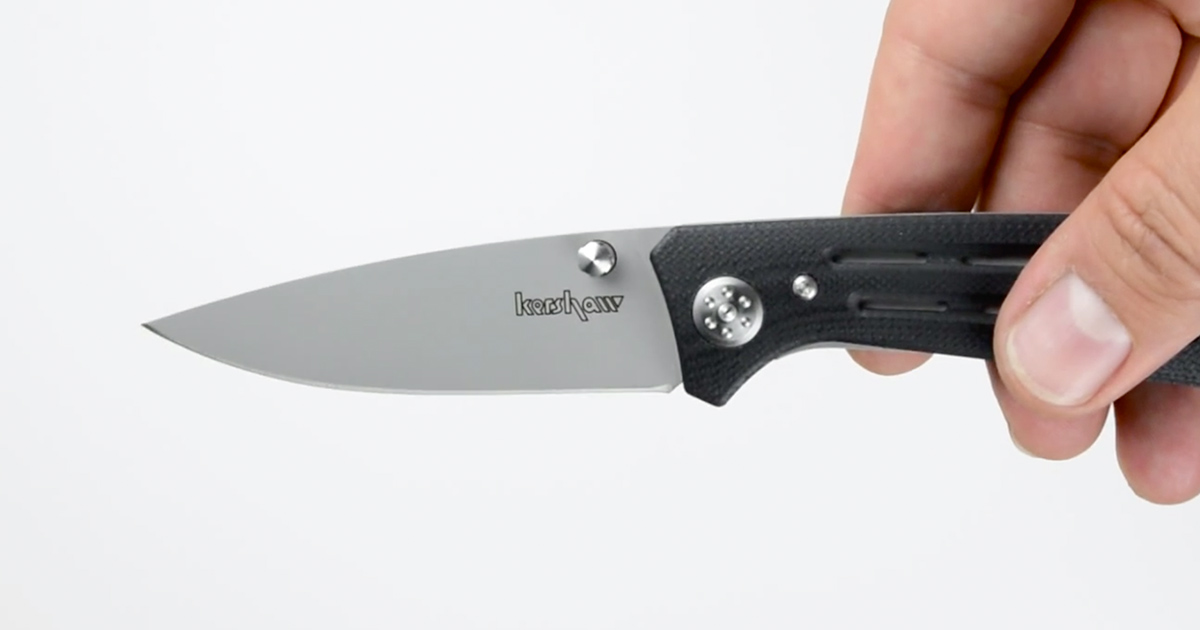
The thumb stud is a tried-and-true method for opening a knife. While there have been a number of advances in opening (just check out our popular post on knives with unique opening mechanisms), the thumb stud remains a favorite.
However, there are times when the easy to use thumb studs provide a particular annoyance — when the thumb stud is in the cutting path of the blade. Some designs are more egregious than others but if you’re trying to cut something thick cleanly, you shouldn’t have to worry about the thumb stud getting in the way.
Here is a particularly egregious example from a gas station knife.
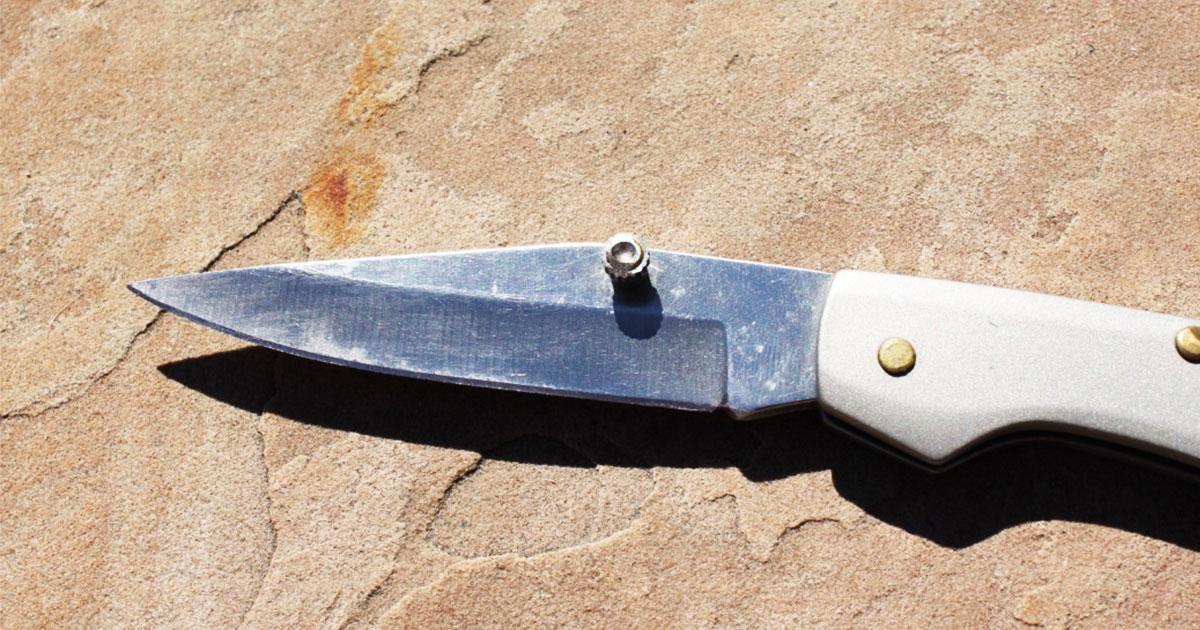
Unnecessary Blade Holes

Holes in the blade have a place. For example, Spyderco has made a living off of having a hole right in the middle of every knife. For the most part, these have a good purpose in aiding the opening of the knife (unless it’s those Spyderco fixed blades that have one for no reason).
https://www.instagram.com/p/BKOPZTUhKXe/
But, when the blade of a knife is filled with unnecessary “speed holes” as I like to call them, it drives me crazy. Cleaning inside these little holes that do nothing but decorate a blade and maybe shave off a few fractions of an ounce is no fun.
Jimping behind a flipper
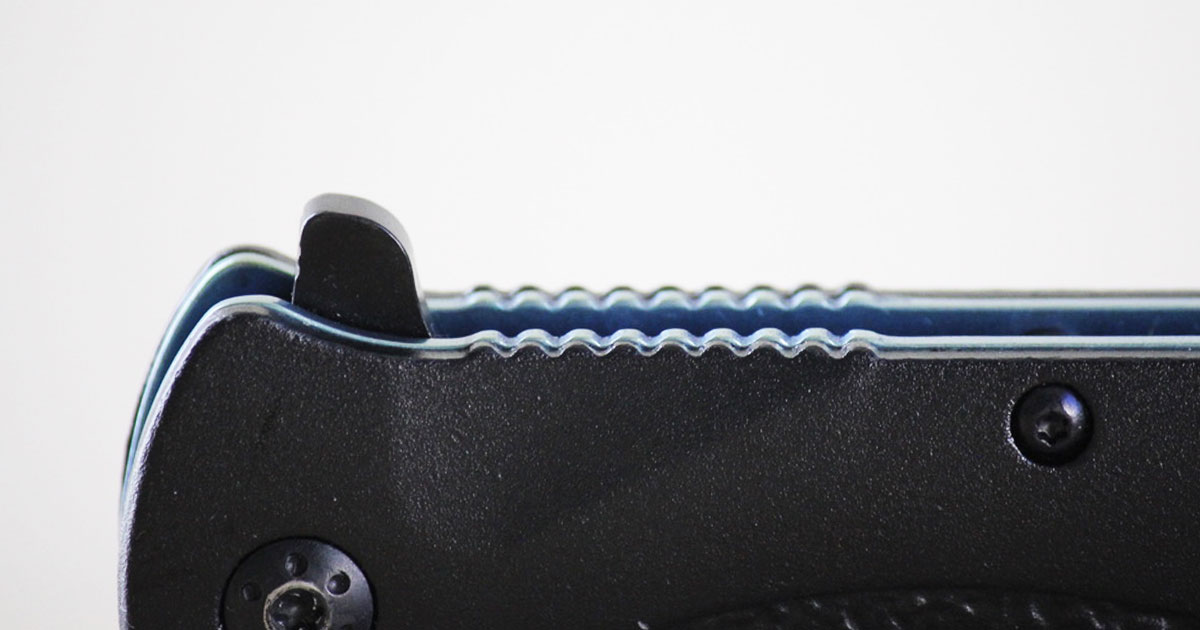
Jimping serves an important function in allowing a user to hold a knife without slippage. Jimping on a flipper tab itself is fine because it makes finding and flipping the knife open easy. Jimping behind a flipper where there should be smooth surface is blasphemy.
There shouldn’t be anything that impedes the engagement of a flipper.
Can’t Make Flat Cuts

If you do even a fraction of the cuts that Pete from Cedric & Ada make with a knife, you want it to be able to cut anything on a flat surface. I find this almost necessary for an EDC that you’re using for everything — from opening boxes to prepping food.
Some knives have a large flipper tab or a reverse recurve (is that a term?) that prevent the bottom of the knife from hitting the ground. A knife like the SpydieChef shows how a nice slicey design should be.
Excessive Billboarding
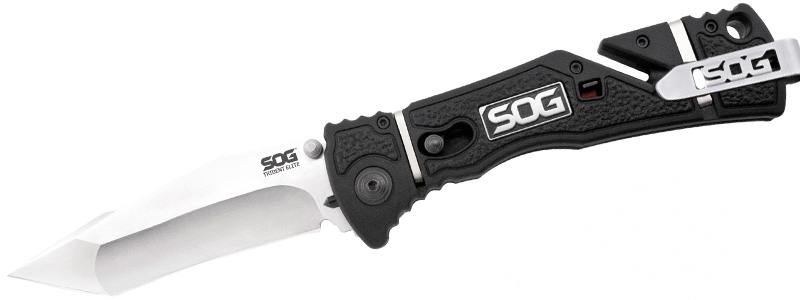
Can you guess who makes this knife?
If you make something, you should put your name on it. It’s only fair. However, having a knife with too much verbiage emblazoned on the blade, handle, and pocket clip is tacky.
Custom designers don’t do this, but brands often take it to the extreme. SOG is known for doing this, but they’ve tampered it down a tad the past few years.
Afterthought Pocket Clips
Speaking of pocket clips — there are some designs that look like the maker created an awesome knife but remembered that they needed a pocket clip and stuck one on after the knife was complete.
For example. Look at this handsome knife.

Then look at the clip.

I’ve written about poor clip designs in the past, but a clip can really make or break a knife — whether it doesn’t vibe with the design or makes holding it too uncomfortable.
Unnecessary Lanyard Hole
Have you ever thought about buying a knife but didn’t because it didn’t have a lanyard hole? Probably not. It seems like knife designers think they have to put in a lanyard hole. If a lanyard hole is present, I don’t mind as long as it doesn’t interfere with other aspects of the design. Unfortunately, that’s not always the case.

Take the Para 3 for example. People ripped the addition of the lanyard hole because it moved down the pocket clip and seems pretty unnecessary. I even think it’s unnecessary on the Paramilitary 2. An unobtrusive design can be found in the Spyderco Delica. For a non-lanyard holed Spyderco, check out the widely hailed Chaparral.
Single Position Clips
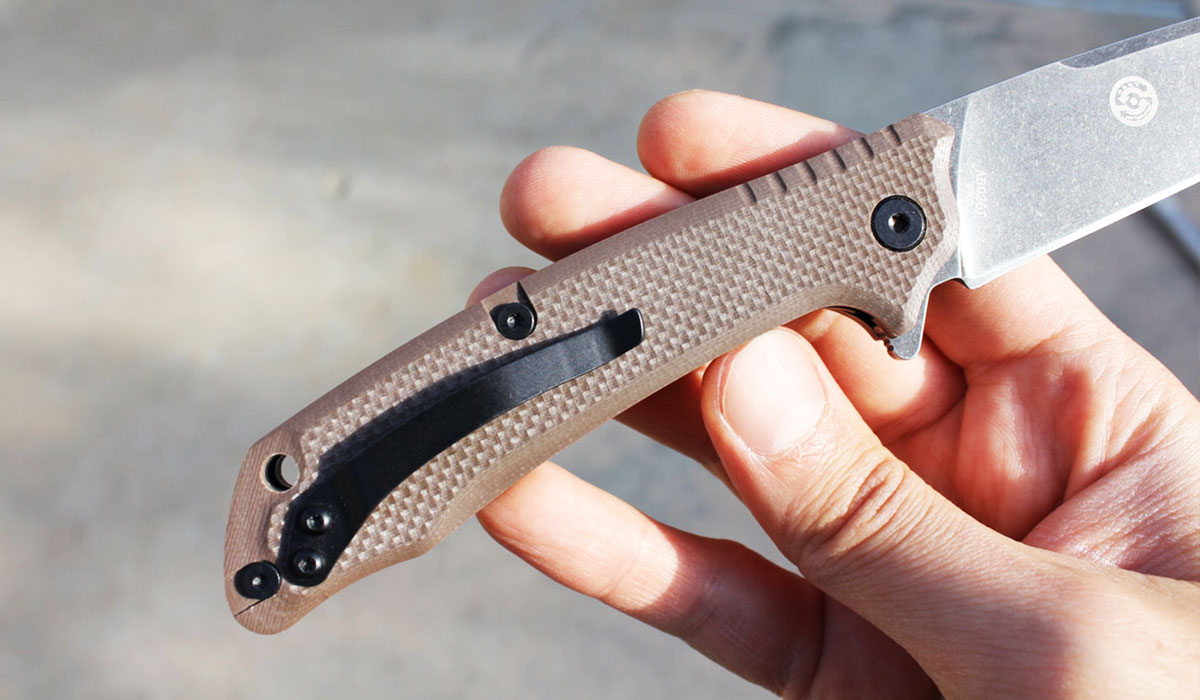
Pocket clips are hard to design — as I talked about in an earlier section — but a single position pocket clip is an annoying feature in many knives. You typically find this in budget knives. The reality is that a single-position clip is only annoying to some people. For example, if a knife has a tip-up only clip, person A may love it and person B may hate it. If a knife has a tip-down only clip, person B may love it and person A may hate it.
That’s why clips you can reposition are a great design feature. Of course, unless it’s a four-position clip, there will always be that person who prefers the clip orientation another way. Unfortunately, a designer can’t please everyone at all times.
Huge Flippers
Flippers can be great, but they can also be annoying. Some flipper tabs are small and unobtrusive. Others are way too big.
This pretty much dovetails into the cutting on a flat surface complaint because large flippers are the usual culprit. However, a large flipper can carry terribly in the pocket, look goofy when open, and even open accidentally.
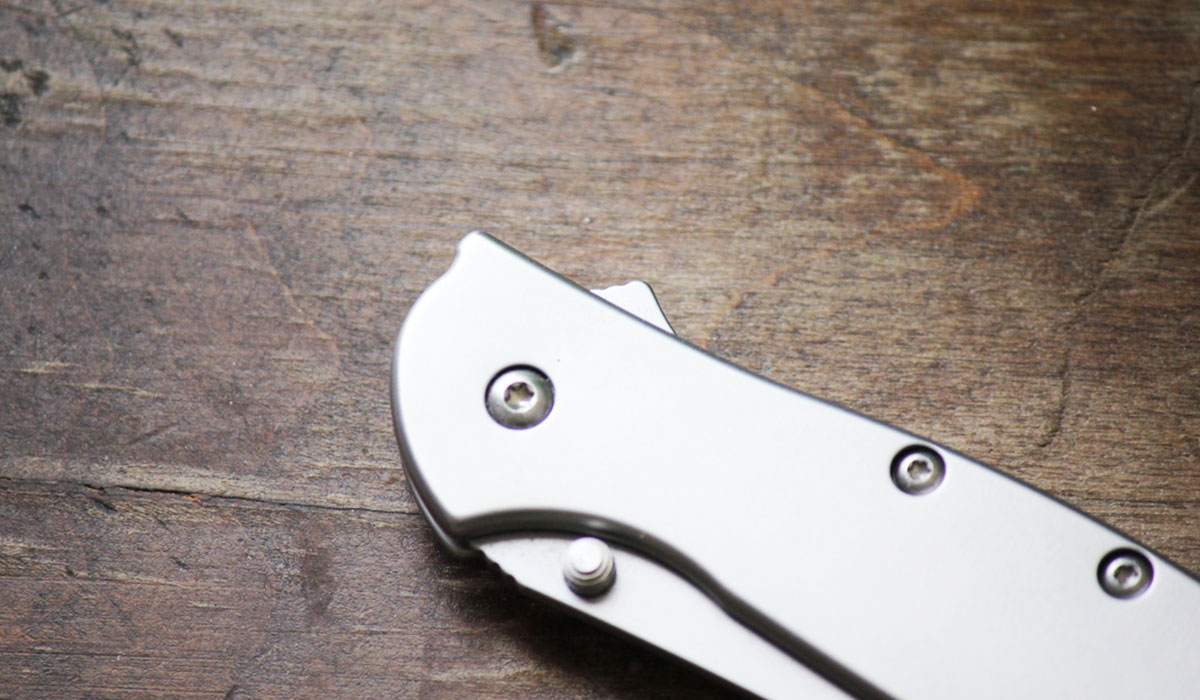
For a well-executed flipper, take a look at the Leek. The flipper is great. It’s small and not pointy and I’ve never had it launch prematurely in my pocket — even though it has the SpeedSafe mechanism. It also pretty much disappears when open. While some flippers work well as a guard, a good flipper can also fade into the background.
What other design annoyances did we miss?
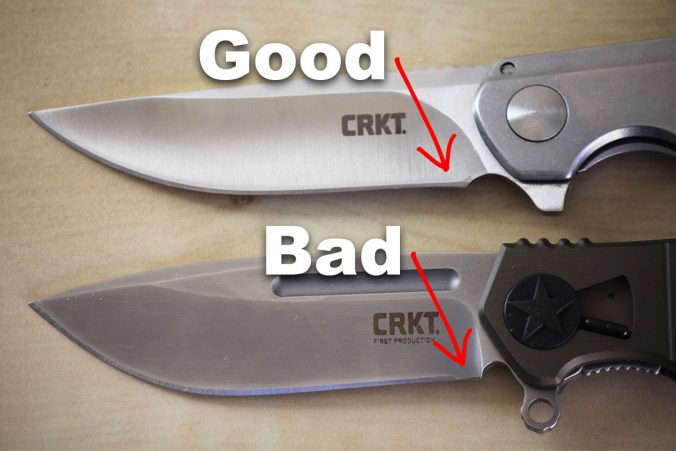




November 1, 2018 at 11:06 am
Talk about having too much time on your hands and getting ultra nit picky, if you don’t like those features you are so critical of, Don’t Buy A Knife That Has Them.
But if you happen to know where I can lay my hands on that skeletonized blue Spyderco, I’ll forgive you!
November 1, 2018 at 1:52 pm
This is all in good fun! Like I said, most of these aren’t really dealbreakers. And about the Spyderco Q… you’re out of luck. That specific version only had 75 made and was commissioned by the Rocky Mountain Blade Collectors club.
February 27, 2019 at 1:26 am
Real dealbreakers for me are pocket clips exclusively for right-handers.
July 9, 2020 at 10:05 pm
I don’t get why anyone would razz you for this excellent article. It was fully-self aware and good natured, yet stimulating and informative. For me, this scored 10/10. Thanks so much for taking the time to put this out there. Ill be keeping my eye out and looking forward to your stuff in the future.
March 16, 2021 at 3:12 pm
Bottle openers on any knife that’s not a multi-tool, Scout or Swiss Army knife. Bad enough on folders … egregiously stupid on fixed blades. So, no, I won’t buy one …
March 17, 2021 at 12:23 am
The one with the holes under the “two many holes” caption has the Benchmade butterfly on the blade…what model I cannot say!
October 8, 2021 at 4:30 am
My first knife was the simple elegance of a three imch Buck at the age of nine. I’ve had a knife of some description all my life. My favorites are the Buck, which I also handed down to my oldest son, Case knives and Uncle Henry Schrade blades. I don’t buy cheap crap, so most of these are off the table from the jump.
Today, I’m tooling up to make my own blades and found this thread after months of Master Smith video tutorials which all concur that the more features you “cut” into a blade design, the more you undermine the strength of the steel. Even an etched maker’s mark at the wrong location or concurrent along the grain of the steel can cause a catastrophic failure under stress, much less a useless and gaudy hole in the middle of the steel.
March 27, 2024 at 2:07 am
Sorry GomeznSA, but I disagree. I think this was a VERY helpful article that summarized several design issues we can check for when evaluating and selecting a knife. Sometimes we might just be drawn to a knife by how it looks, but not consider some of these ‘dysfunctional design’ issues until we have already bought the knife and discovered the problem during use.
One of my hobbies is to research, collect, and use knives. I guess I’m a ‘knife nerd’, but love taking time to read articles such as this one. I also think there are MANY other guys in the “knife community” out there who feel the same way.
Thanks for another great article Tim!
November 1, 2018 at 11:09 am
Knives should not need safeties. My Leek safety is always moving. I disengage it, and merely by turning the knife around in my hand to open it, it goes to half-safe. Why can’t the spring hold the blade closed without a safety?
November 1, 2018 at 6:03 pm
MATH…just saying…
May 21, 2019 at 8:23 am
Fully open the safety: use a T6 to tighten the screw: problem solved. I’ve done this to all 6 of my Leeks and the safeties have never closed.
November 2, 2018 at 1:55 am
Artsy-fartsy knife pictures on instagram are annoying.
February 26, 2019 at 4:42 pm
Alas, you are not explaining the function of the sharpening choil correctly at all:
– Look at your folding blade from the bottom; the part that connects to the handle has to be thick for strength and for connecting with the pivot. Clearly, the cutting edge has to be thin for cutting.
– It follows that there has to be a reduction in thickness. You could reduce it linearly, but then you’d be making a spearhead where the bottom edge is still crazy thick in the back.
– Therefore, you don’t do it gradually, you make a plunge grind where it ‘jumps’ to thin very quickly. Good.
– But not good enough, because there will still be a small area at the base where it goes from thick to thin. You could say that’s no big deal….
– But, if you want to sharpen the blade on a flat stone, that bit of extra thickness messes it up for the whole back area of the blade, because you can’t lay it onto the stone flat.
– Then one thing that will happen is that you’ll try to get it thin enough by grinding it more; that’s grinding the secondary bevel higher and higher in this little area. They call that ‘a smile’
– That looks messy and unrefined.
– One solution of that is to simply grind a notch into the offending are at the back of the blade, just so that everything at and around the secondary bevel can be the same thickness; no muss no fuss.
– And that’s what the sharpening choil does.
March 16, 2021 at 11:07 am
I agree, but also…
If the thickened portion is close enough to the finger guard, and the finger guard is not too long (front to back), then there is absolutely no reason for a “finger choil”.
Far too many knives have a huge amount of blade space (1″ or more) completely wasted by a finger choil in a design where there does not need to be one. I have rejected SO many field knives over that serious flaw. And it occurs in some very big-name models.
May 21, 2019 at 11:31 am
My pet peeve is the “finger choil”, there supposedly to allow “choking up” on the knife for better control. HOGWASH! If the handle was there to begin with you’d have the same thing otherwise you’re just adding wasted blade length. Jimping or checkering about 2/3 of the way down the spine would be more useful.
April 15, 2022 at 9:16 am
Good point.
The only think a finger choil is useful on is smaller folders. Something like a Cold Steel Tuff Lite, Civivi Baby Banter or several Spyderco designs. Then you can have a design that folds up very small but you can still get a nice full grip on the handle.
March 27, 2024 at 2:22 am
Hi RL Diehl,
I think it comes down to how well the finger choil is designed and integrated into the design/function of the knife as a whole. For example, the finger choil on the Spyderco ParaMilitary 2 is superbly designed and very functional for more controlled cuts without reducing or interfering with the actual cutting surface on the blade. You’ve got to hold one in your hand and use it to see the difference between power cuts without using the finger choil and controlled cuts while using the choil.
I do agree with you that there are many knives with poorly designed finger choils that are either unnecessary for the size and handle design of the knife and/or reduce the blade’s cutting surface and/or are too small to safely use without cutting your finger, etc.; however, if it is done right, a finger choil can dramatically improve the funtional use of the knife.
May 21, 2019 at 6:28 pm
One that really gets me is something that can be opened with one hand and has a tip-down clip. And if it can be opened with one hand I think it should be closable with one hand. And I’m not specifying liner lockers. I like lightweight butterfly knives that have cutting/skinning style blades. I have a couple of Hackman from Finland. The blades are 3/4 inch wide and with nylon handles weigh about 2 ounces. They come tight so I had to loosen it to make it open easily. The Filipinos say they stabbed a quarter to test theirs. Their quarters were silver. Mine will stab a modern copper/zinc one without tip damage.
March 4, 2020 at 11:50 am
China made knives wrapped in USA address. Sorry just my opinion.
January 28, 2021 at 10:52 am
Brilliant speed holes reference, I like your style, got a good chuckle out of that 😀
March 17, 2021 at 11:27 am
Actually, with respect to the top picture, both of these choils are badly designed/executed, in my view.
December 9, 2021 at 3:06 pm
I agree with a lot of these but the holes? It can make a knife super interesting to look at. I love the Benchmade that you featured as the egregious design. I also don’t mind the afterthought pocket clip on the benchmade knife of offending design. Maybe I just like Benchmade. I would WAY rather have a hole or two or three over a thumb stud ANYDAY of the week. The excessive billboarding and incomplete sharpening choil is spot on though.